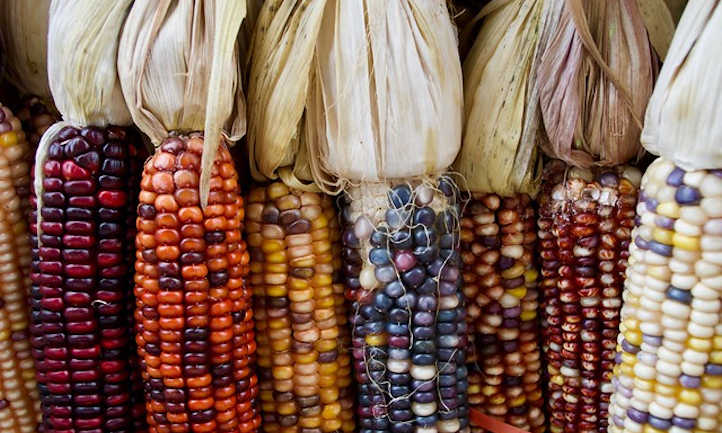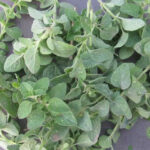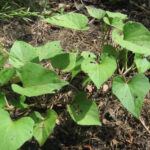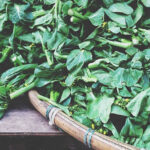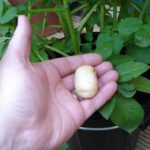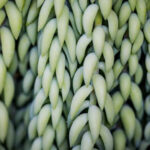Most people think of corn as that mid-summer fresh sweet corn on the cob treat. But corn is so much more! There are thousands of different types of corn and thousands of different ways to eat it. Preparations range from bowls of spicy posole to grits, tortillas, “nuts”, beer, popcorn, tamales, bread, and so on. If you’re only eating fresh sweet corn on the cob you are really missing out!
One of the reasons corn is so incredibly versatile in the kitchen is that corn is so easily modified. Beginning with genius plant breeding techniques of indigenous peoples 8,000 years ago, corn has evolved to grow in nearly all growing climates and elevations. There are several different categories of corn based on their textural qualities of the kernels that have different culinary uses.
Even if you don’t grow your own corn, it is a part of everyday life as corn has infused into many industrial processes, biofuels, and animal feed. Learning more about corn and how it grows will give you a whole new appreciation for this remarkable crop.
The History Of Corn
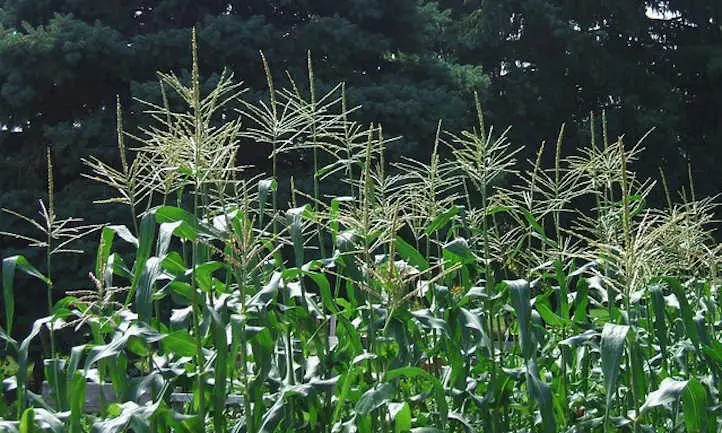
Corn is one of the oldest domesticated crops. The origin of corn began in what is now Central Mexico around 8,000-9,000 years ago.
Corn was domesticated from a wild grass known as teosinte which resembles modern corn in that it has similar green stalks and leaves and forms tassels on top. But the ears are tiny, only one-two inches long with few rock hard seeds.
Over thousands of years indigenous peoples experimented with the culinary qualities of teosinte, selected seeds and promoted the growth of traits they liked. Teosinte can be popped when the kernels are dry and is also a soft, sweet tasting seed when eaten green. Anyone from the plains states can attest that the base of wild grasses are sweet and delicious. Teosinte is no different!
Through their genius plant breeding techniques around 6,000 years ago corn resembled what we recognize as corn: a central cob circled by kernels. This early corn was popcorn and quickly spread throughout North and South America through the movement of people and sharing of seeds. Plant breeders continued their work developing different varieties and pushing this tropically adapted grass to grow in new environments.
Archaeologists have identified the earliest corn in the Southwestern deserts from sites dating to 4,000 years ago which was the entryway for corn in what is now the United States. Around 2,000 years ago people were growing popcorn varieties alongside flour corn varieties which were likely developed because of their ease of grinding and flexibility in the kitchen.
Reliance of corn in the diet increased as did the diversity of varieties. By 1,500 -1,000 years ago, corn was commonly grown throughout the temperate regions of what is now the United States and southern Canada joining other crops like pumpkin, beans, amaranth, tobacco, and sunflower. Corn began to spread throughout the globe 500 years ago after the colonization of indigenous peoples by Europeans.
Different varieties of corn are now one of the biggest agricultural commodities in the world and make up a significant portion of the human population’s calories along with wheat and rice. Beyond food, different types of corn are grown for animal feed, industrial products, and biofuels. Because of this, corn is also one of the most manipulated crops with new selections being introduced each year. Methods to develop this corn range from classical plant breeding techniques used to develop corn over thousands of years to CRISPER gene editing technology.
The Most Common Types Of Corn
There are tens of thousands of different types of corn varieties in existence today, and many that have been lost to monoculture and industrial farming. Some varieties are widely available and adaptable while others are adapted to the unique growing conditions of a specific valley. All of this diversity offers unique culinary uses, flavor, or color.
Over 28,000 unique collections of maize are conserved within the germplasm bank of the International Maize and Wheat Improvement Center in Mexico City, the heart of corn diversity. Thousands of other unique collections exist in smaller national and regional seed banks. While the diversity in corn is immense, corn can be grouped into several categories based on the kernel structure which gives each corn unique culinary traits.
With so many different types of corn to choose from it can be overwhelming. First, think about what you are most likely to eat and varieties that will grow in your region. Select varieties that originate from your area and are adapted to your growing season. All the different types and varieties are the same species, Zea mays, and because it is wind-pollinated, corn can very easily cross-pollinate. It may be tempting to try several varieties but stick to one per season so that you have plenty of space and avoid undesirable mixing between varieties.
Sweet Corn
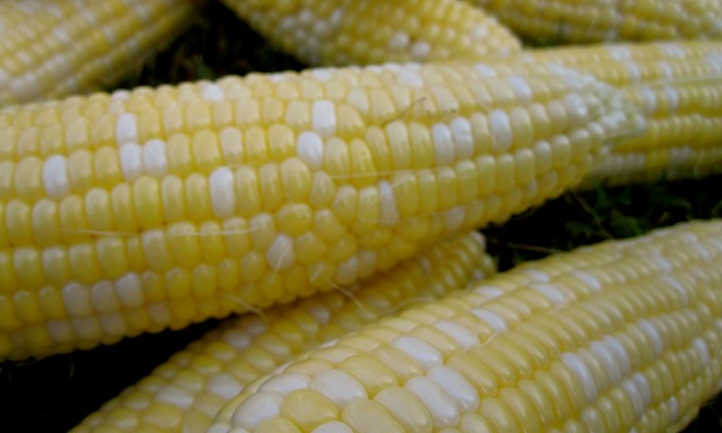
A majority of gardeners and seed catalogs focus on sweet corn because it is most familiar and approachable for the home kitchen. Nothing says summer like a fresh ear eaten right off the cob!
Sweet corn is best picked at its early or “milk” stage when it is still tender and juicy. The milk stage of sweet corn is identified by the release of a milky substance from the kernel when pressed with a thumbnail and occurs a week to 20 days after the corn tassel begins to shed pollen.
Sweet corn originated from genetic mutations in harder flint and flour corns which prevented the conversion of sugars into starch. The milk stage of flint and flour corn varieties is mildly sweet tasting but starchy and chewy.
When you open a packet of sweet corn seeds for planting, the kernels should be wrinkled as the sugars that dominate have dehydrated. As soon as the fresh ear of corn is picked the sugars start to dehydrate, so consume it right away. Home grown tastes so much better than store bought!
Dozens of quality heirloom varieties are widely available including Stowell’s Evergreen, and Golden Bantam. More and more sweet corn hybrids are released all the time in the United States, with breeding for supersweet kernels, disease resistance, and early maturity. Look for white, yellow, or a bicolor that includes both types such as Peaches and Cream.
Sweet corn, like Double Standard is the ideal corn to be eaten fresh in its green or milk stage, but it can also be roasted, dried, and reconstituted (as with chicos, a New Mexican preparation). You can even go as far as to grind dried sweet corn into a deliciously sweet cornmeal.
Flour Corn
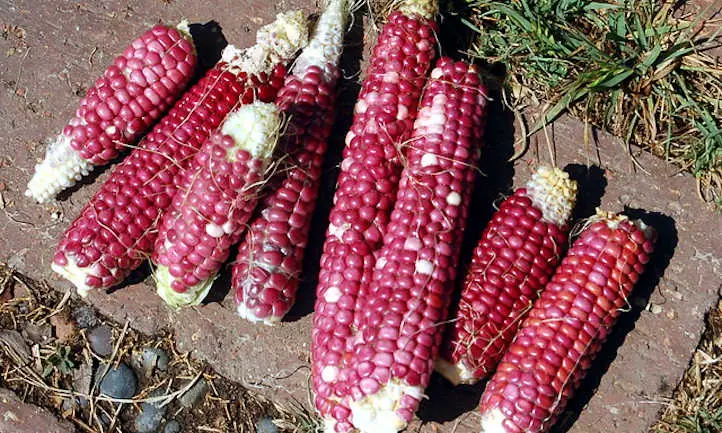
Flour corn is composed mainly of soft starch, which gives it the ability to be easily ground into a fine cornmeal. Flour corn varieties can grow from short 2 foot varieties to varieties 8-10 feet tall and grow well in areas that are drier. The ears are typically long and slender and can be harvested in its immature or “milk” stage. Common preparation methods include steaming, boiling, or roasting.
While it is sweeter and more tender than flint types in this stage, it is not as sweet as sweet corn types. Most often flour corn is harvested when fully ripe and dry and ground into cornmeal.
The flavor of flour corn is subtle and delicate. Without the dense oils and proteins packed into the endosperm, the flavor is not as rich as types of flint corn. Blue and red varieties have the most flavor as well as nutrition from an abundance of antioxidants and carotenoids.
Flour corn’s soft texture makes it much easier to grind and digest, which is why most preparations are with the fine cornmeal they produce. There’s many uses for food products like breads, tortillas, tamales, or pinole (cornmeal added to drinks). Flour corn kernels can also be left whole and parched for corn nuts and made into posole. Dried kernels can be ground with a powerful blender or food processor or a hand crank grinder which brings out the best flavor. Toasting whole kernels or the ground cornmeal intensifies the flavor and adds a nutty richness.
Flour corn varieties come in a rainbow of colors and even different patterns. Some of the most beautiful contain speckles and stripes. There are efforts among the Pawnee Seed Preservation Project to restore Eagle corn known for the dark spots that resemble birds in flight on each kernel.
Hopi Blue, Seneca White, and Apache Red are just some of the varieties of flour corn. Most Native American communities have their own version of white, blue, red, yellow, and multicolored flour corns adapted to their growing environment. The commercially available variety Painted Mountain contains a colorful array with no ear looking like any other.
The color is contained within the thin outer layer of the corn kernel while the interior soft starch is white. Therefore, most ground cornmeal will have a white-gray appearance with a hint of kernel color. Color in the final cooked product is intensified by adding an alkaline material such as wood ash or completing the nixtamalization process.
Nixtamalization is a preparation where the corn is soaked and cooked in water with food grade cal (calcium hydroxide) or pickling lime and then hulled to remove the outer shell which also softens the kernel. It is named after the Nahuatl (language spoken by many indigenous Mexicans) word nextamalli, a combination of the words for lime or cal and tamale. This process alters the chemical composition of the corn, intensifying color, but also altering the flavor, giving it the bite and aroma of a tortilla chip. The resulting kernels are referred to as posole or hominy and ground nixtamalized corn commonly called masa or nixtamal.
The alkaline treatment also alters the nutritional availability of the corn allowing for more of the protein and niacin to be digested. Wood ash, such as juniper traditionally used by Navajo (Diné) people, also imparts a significant amount of calcium. A bowl of traditional blue corn mush, hot porridge of ground cornmeal, has as much calcium as a glass of milk.
Dent or Field Corn
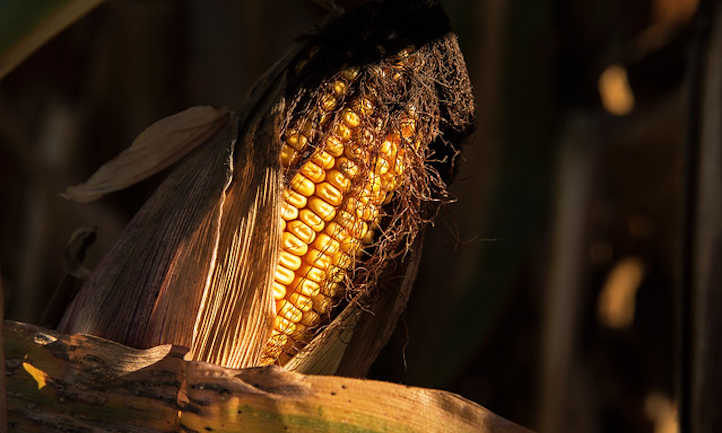
Dent corn is named after the indentation that appears at the top of the kernel as it dries. The kernels contain a hard form of starch at the sides and a soft starch type in the center. These center starches tend to shrink as the kernel dries, creating a “dent” in the top of the kernel.
Ears produced from dent varieties tend to be large and hefty and therefore they have tall, strong stalks to support their weight. Typically, the plants do not bush out with numerous stalks, called tillers, which is a common trait in heirloom flour and flint types. The tall single stalks also make them attractive for harvesting with large-scale commercial equipment and for use in corn mazes.
Also known as “field corn”, dent corn makes up the majority of commercially raised corn in the world, and it’s no different in the United States. It is primarily used for livestock feed, silage, corn gluten meal, food products from cornbread to tortilla chips, and further refined into high-fructose corn syrup, plastics, and ethanol. Because of the commercial applications, much of the dent corn varieties grown are GMO or hybrids.
Dent corn has a high starch content and can be ground into cornmeal when harvested dry. The medium granular texture is also ideal for grits. Dry kernels can be nixtamalized to make hominy to grind into masa or hominy grits (ground after the nixtamalization process and preferred in many areas of the Southern US).
Harvested fresh, dent corn is used for elotes in Mexico (corn on the cob with condiments such as salt, chile powder, butter, cotija, lemon juice or lime juice, and mayonnaise) but is being replaced with more flavorful sweet corn varieties. When harvested just past the height of the milk stage it makes an ideal green corn tamale base, providing some stiffness to the dough but retaining the sweetness of the milk stage.
There are fewer dent corn varieties available to the home gardener with some notable exceptions. The popular Oaxacan Green and Bloody Butcher from many retailers as well as Dia de San Juan from Native Seeds/SEARCH is prized for green corn tamales.
Flint Corn
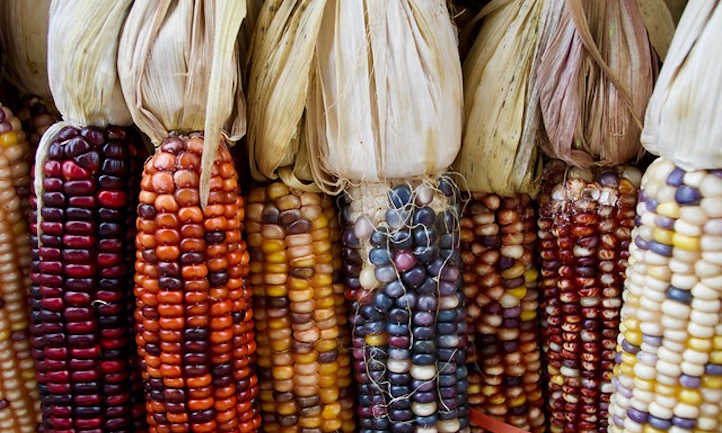
This type of corn has a hard outer layer which protects the small, soft endosperm inside the kernel. This hard outer layer is said to be “as hard as flint” hence the name. Flint corn has a glassy appearance and typically has long, slender ears. In addition, flint corn comes in a large range of colors and are often very tall plants.
Unfortunately, many people miss out on the culinary qualities of flint corn and sideline them as decorative. However, flint corn packs a lot of flavor. Flint corn can be nixtamalized and made into masa and hominy or ground when dry to make a coarse grind cornmeal ideal for polenta. Flint corns can also be “popped” when heated, but often the kernels will crack open rather than fully explode. Still tasty as a type of corn nut. The hardness of the kernel allows flint varieties to store very well and be less susceptible to insect and rodent predation.
Flint types of corn available for gardeners include Chapalote, a variety documented to be continuously grown in the Southwestern US for 4,000 years, and Roy Calais Flint, an 8-row variety for northern climates. Floriani Red is an Italian heirloom gaining popularity in the US for polenta.
Popcorn
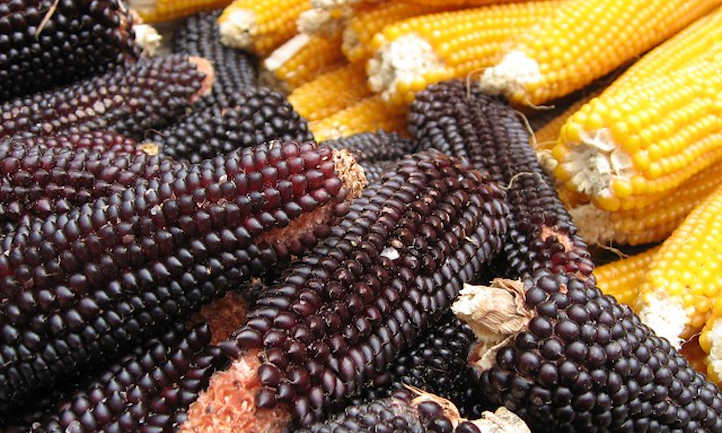
Popcorn is the oldest domesticated type of corn and has a very similar glassy appearance to flint corn, but in miniature with smaller kernels and ears. When popcorn is heated, the moisture inside the kernel turns to steam that explodes the starch inside, literally turning the kernel inside out. The result is the white, starchy, crunchy treat that is familiar to all. Popcorn is very approachable for the home gardener because it doesn’t require extra time for processing to make edible and many varieties have a short space saving stature.
Popcorn comes in a range of colors including single colored varieties like the yellow Tom Thumb or the red Strawberry to the multi-colored rainbow varieties like Cochiti and Glass Gem. Popcorn is harvested when the ears are dry and the kernels hard. Too little or much moisture will result in poor popping. Because of the high starch content of the kernel, popcorn is extremely chewy when harvested at the fresh milk stage and best left to fully mature.
It is not the variety of popcorn that will result in bright red or rainbow popcorn. All popcorn pops a white color due to the color of the endosperm (starch), but if you look close enough, you may see a little bit of the color in the middle of the exploded kernel. That is the pericarp, or outer hull where the kernel color comes from. Those are the pesky bits that get stuck in your teeth.

